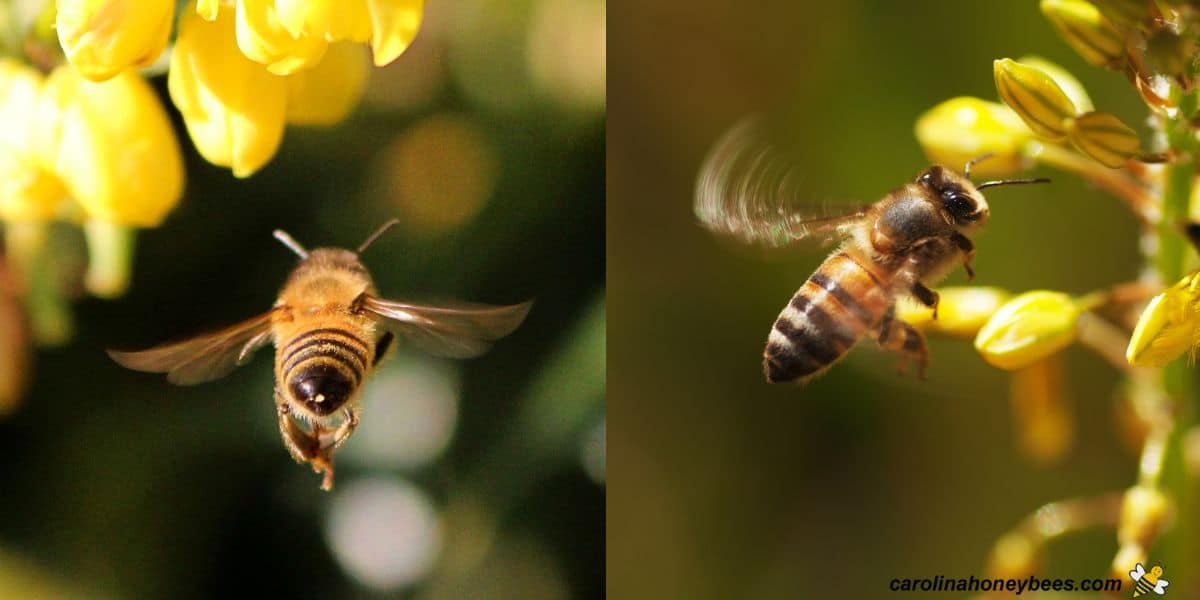How do Bees Fly?
Until recent years, scientists did not understand the facts of – how do bees fly? The honey bee in particular was a puzzle to scientists. Impossible they said – a honey bee should not be able to fly. The wings are too small for their plump little bodies. But, fly they do and they do a good job of traveling near and far to gather food.

A Flying Honey Bee – Impossible They Said
Researchers and scientists yearn to understand “why”. They want to know why things work the way they do.
The flight of honey bees represented a puzzle for scientists. The mathematical data of bee flight that could be measured and observed at the time – did not add up.
Honey bees should not be able to fly. But, bees did fly and continue to do so, regardless of what science could not understand.

Flight Rules that Honey Bees Seem to Break
In a most basic study of physics, there are several factors involved that makes it possible for anything to fly – whether an insect or an airplane.
Flight is possible because of the interaction of the forces of:
- drag
- weight
- and thrust.
A quick study of honey bee anatomy reveals that they have 4 wings – a larger pair of forewings and a pair of smaller wings in the back.
There seemed to be no way that honey bees could fly with their small, rigid wings. The wings were too small in comparison to their body size and weight.
No matter how fast the four wings beat, it should not create enough lift to get the bee off the ground – according to the known laws of aviation.
Only in recent years, was the answer revealed. High resolution video was taken of a flying honey bee. When played in slow motion the answer to the problem became clear.

Flexible Wings
Contrary to earlier belief, bee wings are not rigid. And, they do not move solely in an up and down wing stroke. This may appear to be a small difference but it is very important in the understanding of flight.
The wings of honey bees are flexible and able to move in a rotating pattern. Instead of beating straight up and down, the wings also make sweeping motions front to back. The angle of the wing creates vortices that create lift.
Small hooks called “hamuli” make it possible for the bee to hook the wings on each side together. When the two wings are joined, they flap together giving the bee more lift capacity.
Muscles in the thorax of the bee cause the wings to be able to move very fast. Honey bees can flap their wings up to 230 times per second.
But, honey bees need to maintain body temperatures to be able to fly. This is why I sometimes find myself reviving a bee that is tired and cold on an early Spring day.
Flight Speeds
Not all bees (or bee-like insects) fly in the same way. For instance, bumble bees share some of the same characteristics as honey bees. But, their size and life style is different.
Their bodies must perform different tasks. This leads to some variation between average flight speed of various bees and wasps.
- honeybees: 12-20 mph
- yellow jackets: 7-30 mph
- bumble bees: 7-33 mph
- hornets: 14-25 mph
Honey Bees Fly Differently
Honey bees are not insect predators. They focus on gathering things that the colony needs to survive. Perhaps this different method of flying is due to the need of the honey bee to carry large loads.
A worker bee is not simply moving from one location to another. Foraging bees collect all the resources needed by the colony. This effort requires healthy bees with strong flight muscles.

When a foraging bee flies from the hive, she will be light weight and fast. As she gathers pollen or nectar from flowers, her flight weight increases. Honey bees can travel miles from their hive if necessary.
In addition to being strong, bee flight has to be adaptable. At times it is necessary for the honey bee to fly slower as she moves from flower to flower.
The work necessary for bees to make honey – even a little – requires many trips for nectar collection. All of this work is during during the daylight hours because honey bees do not normally fly at night.
FAQs
The muscles in the spongy thorax of bees allow wings to move very fast. The fast beating wings create air vibrations that we hear as a buzz.
Bees can make a buzzing sound when not in flight too. Bumble Bees often do this to shake pollen from a flower.
Healthy worker honey bees can fly up to 15-20 mph (21-29km/h). The average adult human can run about 15 mph. Important tip: don’t get into a foot race with a honey bee.
Of course, a foraging worker loaded down with nectar, pollen or water would fly slower – averaging about 12 mph or less.
Rather than how high can bee fly, it becomes an issue of not wasting energy. They fly to where the food is when it is in their power to do so.
Otherwise, because bees are cold blooded insects, they need a certain thermal temperature to survive. It would stand to reason that once they reached a certain height, their wings would not be able to beat fast enough to sustain lift.
A honey bee can carry an average of 15 gm of pollen and up to 20 gm of nectar. Bumble bees are the true heavy lifters. They are able to carry up to and over 60% of their body weight.
Wings hooked together helps the bee fly. Unhooking allows the wings to lay flat against the body while inside the hive.
Much like you going inside the house with your umbrella opened up to full size. It just would not work inside a hive of thousands.
Also, being able to unhook the wing pairs allows the honey bee to vibrate wing muscles and generate heat to ensure Winter survival of the bee colony.
Final Thoughts
Modern technology made it possible to study a flying bee in a way never seen before. However, as wonderful as these insects are – bees do not fly in hard rain or high winds. Hard rain could break their wings and in windy weather the effort often outweighs the rewards.
The special features of bees’ wings (structure) and the method in which they rotate makes it possible for a honey bee to fly.

